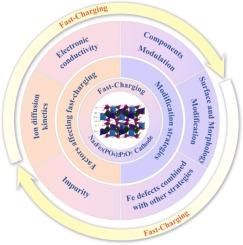钠离子电池用快速充电负极Na4Fe3(PO4)2P2O7
IF 3.3
4区 材料科学
Q3 CHEMISTRY, PHYSICAL
引用次数: 0
摘要
发展快速充电二次电池是提高可再生能源利用率和实现全球碳中和的关键战略。基于钠的固有性质及其资源优势,钠离子电池在该领域具有广阔的应用前景。高效的正极材料作为电池的重要组成部分,是实现快速充电技术的关键。Na4Fe3(PO4)2P2O7作为高性能的聚阴离子正极材料,在快速充电方面具有很大的潜力,值得进一步研究。然而,它的实际应用仍然受到本质上低的电子导电性、缓慢的Na+扩散动力学以及在合成过程中形成不希望的杂质相的阻碍。目前快速充电Na4Fe3(PO4)2P2O7阴极的研究现状和改性策略主要集中在表面和形貌改性、有源组分调制和抑制杂质生成三个方面。本文综述了这些方法,旨在为NFPP作为钠离子电池的快速充电阴极的合理设计和进一步开发提供见解。本文章由计算机程序翻译,如有差异,请以英文原文为准。

Fast-charging Na4Fe3(PO4)2P2O7 cathode for sodium-ion batteries
Developing fast-charging secondary batteries is a key strategy to enhance the utilization of renewable energy sources and achieve global carbon neutrality. Based on the intrinsic properties of sodium and its resource advantages, sodium-ion batteries hold promising prospects in this field. As a crucial component of batteries, efficient cathode materials are vital for the realization of fast-charging technology. Na4Fe3(PO4)2P2O7, as a high-performance polyanionic cathode material, shows great potential for fast-charging and warrants further research. However, its practical application is still hindered by intrinsically low electronic conductivity, sluggish Na+ diffusion kinetics, and the formation of undesired impurity phases during synthesis. The current research status and modification strategies for fast-charging Na4Fe3(PO4)2P2O7 cathodes mainly focus on three aspects: surface and morphology modification, active component modulation, and inhibition of impurity generation. This review provides a summary of these approaches, aiming to offer insights into the rational design and further development of NFPP as a fast-charging cathode for sodium-ion batteries.
求助全文
通过发布文献求助,成功后即可免费获取论文全文。
去求助
来源期刊

Solid State Ionics
物理-物理:凝聚态物理
CiteScore
6.10
自引率
3.10%
发文量
152
审稿时长
58 days
期刊介绍:
This interdisciplinary journal is devoted to the physics, chemistry and materials science of diffusion, mass transport, and reactivity of solids. The major part of each issue is devoted to articles on:
(i) physics and chemistry of defects in solids;
(ii) reactions in and on solids, e.g. intercalation, corrosion, oxidation, sintering;
(iii) ion transport measurements, mechanisms and theory;
(iv) solid state electrochemistry;
(v) ionically-electronically mixed conducting solids.
Related technological applications are also included, provided their characteristics are interpreted in terms of the basic solid state properties.
Review papers and relevant symposium proceedings are welcome.
 求助内容:
求助内容: 应助结果提醒方式:
应助结果提醒方式:


